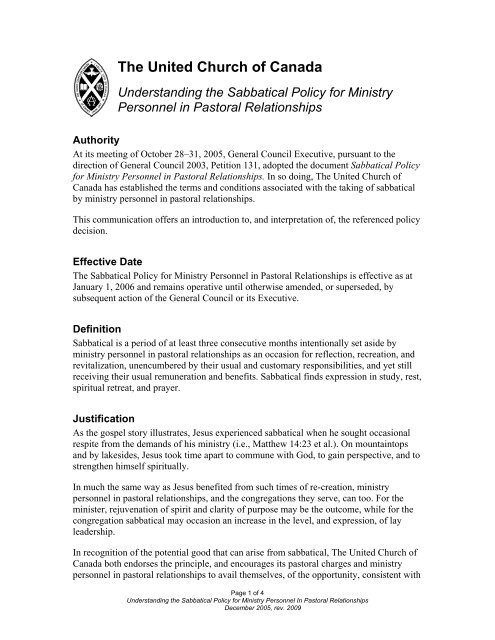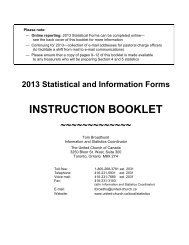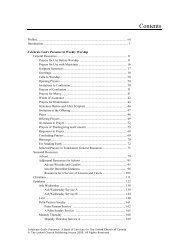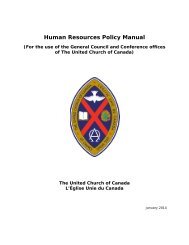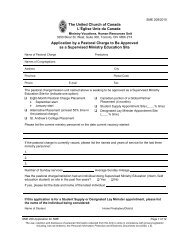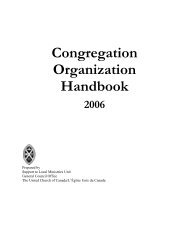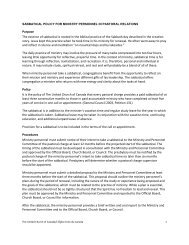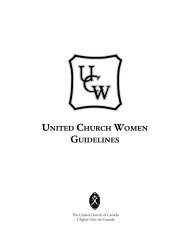Understanding the Sabbatical Policy for Ministry Personnel in ...
Understanding the Sabbatical Policy for Ministry Personnel in ...
Understanding the Sabbatical Policy for Ministry Personnel in ...
Create successful ePaper yourself
Turn your PDF publications into a flip-book with our unique Google optimized e-Paper software.
The United Church of Canada<br />
<strong>Understand<strong>in</strong>g</strong> <strong>the</strong> <strong>Sabbatical</strong> <strong>Policy</strong> <strong>for</strong> <strong>M<strong>in</strong>istry</strong><br />
<strong>Personnel</strong> <strong>in</strong> Pastoral Relationships<br />
Authority<br />
At its meet<strong>in</strong>g of October 28–31, 2005, General Council Executive, pursuant to <strong>the</strong><br />
direction of General Council 2003, Petition 131, adopted <strong>the</strong> document <strong>Sabbatical</strong> <strong>Policy</strong><br />
<strong>for</strong> <strong>M<strong>in</strong>istry</strong> <strong>Personnel</strong> <strong>in</strong> Pastoral Relationships. In so do<strong>in</strong>g, The United Church of<br />
Canada has established <strong>the</strong> terms and conditions associated with <strong>the</strong> tak<strong>in</strong>g of sabbatical<br />
by m<strong>in</strong>istry personnel <strong>in</strong> pastoral relationships.<br />
This communication offers an <strong>in</strong>troduction to, and <strong>in</strong>terpretation of, <strong>the</strong> referenced policy<br />
decision.<br />
Effective Date<br />
The <strong>Sabbatical</strong> <strong>Policy</strong> <strong>for</strong> <strong>M<strong>in</strong>istry</strong> <strong>Personnel</strong> <strong>in</strong> Pastoral Relationships is effective as at<br />
January 1, 2006 and rema<strong>in</strong>s operative until o<strong>the</strong>rwise amended, or superseded, by<br />
subsequent action of <strong>the</strong> General Council or its Executive.<br />
Def<strong>in</strong>ition<br />
<strong>Sabbatical</strong> is a period of at least three consecutive months <strong>in</strong>tentionally set aside by<br />
m<strong>in</strong>istry personnel <strong>in</strong> pastoral relationships as an occasion <strong>for</strong> reflection, recreation, and<br />
revitalization, unencumbered by <strong>the</strong>ir usual and customary responsibilities, and yet still<br />
receiv<strong>in</strong>g <strong>the</strong>ir usual remuneration and benefits. <strong>Sabbatical</strong> f<strong>in</strong>ds expression <strong>in</strong> study, rest,<br />
spiritual retreat, and prayer.<br />
Justification<br />
As <strong>the</strong> gospel story illustrates, Jesus experienced sabbatical when he sought occasional<br />
respite from <strong>the</strong> demands of his m<strong>in</strong>istry (i.e., Mat<strong>the</strong>w 14:23 et al.). On mounta<strong>in</strong>tops<br />
and by lakesides, Jesus took time apart to commune with God, to ga<strong>in</strong> perspective, and to<br />
streng<strong>the</strong>n himself spiritually.<br />
In much <strong>the</strong> same way as Jesus benefited from such times of re-creation, m<strong>in</strong>istry<br />
personnel <strong>in</strong> pastoral relationships, and <strong>the</strong> congregations <strong>the</strong>y serve, can too. For <strong>the</strong><br />
m<strong>in</strong>ister, rejuvenation of spirit and clarity of purpose may be <strong>the</strong> outcome, while <strong>for</strong> <strong>the</strong><br />
congregation sabbatical may occasion an <strong>in</strong>crease <strong>in</strong> <strong>the</strong> level, and expression, of lay<br />
leadership.<br />
In recognition of <strong>the</strong> potential good that can arise from sabbatical, The United Church of<br />
Canada both endorses <strong>the</strong> pr<strong>in</strong>ciple, and encourages its pastoral charges and m<strong>in</strong>istry<br />
personnel <strong>in</strong> pastoral relationships to avail <strong>the</strong>mselves, of <strong>the</strong> opportunity, consistent with<br />
Page 1 of 4<br />
<strong>Understand<strong>in</strong>g</strong> <strong>the</strong> <strong>Sabbatical</strong> <strong>Policy</strong> <strong>for</strong> <strong>M<strong>in</strong>istry</strong> <strong>Personnel</strong> In Pastoral Relationships<br />
December 2005, rev. 2009
<strong>the</strong> considerations and requirements articulated <strong>in</strong> <strong>the</strong> correspond<strong>in</strong>g policy and described<br />
more fully here<strong>in</strong>.<br />
Application<br />
The <strong>Sabbatical</strong> <strong>Policy</strong> <strong>for</strong> <strong>M<strong>in</strong>istry</strong> <strong>Personnel</strong> <strong>in</strong> Pastoral Relationships is applicable to<br />
every pastoral charge and all full- and part-time m<strong>in</strong>istry personnel <strong>in</strong> pastoral<br />
relationships who have completed five or more years of service <strong>in</strong> <strong>the</strong> pastoral charge that<br />
will be party to <strong>the</strong> sabbatical. However, it does not apply to m<strong>in</strong>istry personnel who are<br />
appo<strong>in</strong>ted as Interim <strong>M<strong>in</strong>istry</strong> to a pastoral charge.<br />
Obligations<br />
Pastoral Charge<br />
• To provide a paid sabbatical of at least three consecutive months to <strong>the</strong> m<strong>in</strong>istry<br />
personnel who has completed five or more years of service to <strong>the</strong>m.<br />
• To dialogue and negotiate with <strong>the</strong> m<strong>in</strong>istry personnel, via its <strong>M<strong>in</strong>istry</strong> and<br />
<strong>Personnel</strong> Committee, about <strong>the</strong> length, tim<strong>in</strong>g, and o<strong>the</strong>r specifics of <strong>the</strong><br />
sabbatical, <strong>in</strong>clud<strong>in</strong>g, but not limited to, <strong>the</strong> nature of <strong>the</strong> study or experience<br />
be<strong>in</strong>g proposed and <strong>the</strong> outcomes anticipated.<br />
• To approve <strong>the</strong> sabbatical plan provided that it has as its focus <strong>the</strong> practice of<br />
m<strong>in</strong>istry.<br />
• To cont<strong>in</strong>ue, dur<strong>in</strong>g <strong>the</strong> sabbatical, to pay <strong>the</strong> m<strong>in</strong>istry personnel’s regular salary<br />
and hous<strong>in</strong>g allowance (or to cont<strong>in</strong>ue to provide <strong>the</strong> use of a manse).<br />
• To cont<strong>in</strong>ue, dur<strong>in</strong>g <strong>the</strong> sabbatical, to make regular and usual remittances<br />
associated with <strong>the</strong> m<strong>in</strong>istry personnel to The United Church of Canada <strong>for</strong> health<br />
and pension plans, <strong>the</strong> Employee Assistance Program, <strong>the</strong> Canada Pension Plan,<br />
Employment Insurance, etc., as of <strong>the</strong> day prior to <strong>the</strong> commencement of <strong>the</strong><br />
sabbatical.<br />
• To, <strong>in</strong> those cases where <strong>the</strong> m<strong>in</strong>istry personnel would customarily receive travel<br />
expense reimbursement, calculate and pay, on a monthly basis, an <strong>in</strong>come<br />
supplement of 40 percent of his/her average monthly travel claim (based on <strong>the</strong><br />
six months prior to <strong>the</strong> sabbatical) to <strong>the</strong> m<strong>in</strong>istry personnel, and to duly report <strong>the</strong><br />
benefit as be<strong>in</strong>g taxable.<br />
• To notify <strong>the</strong> presbytery/district of <strong>the</strong> sabbatical, no later than six months prior to<br />
its beg<strong>in</strong>n<strong>in</strong>g.<br />
<strong>M<strong>in</strong>istry</strong> <strong>Personnel</strong><br />
• To advise <strong>the</strong> pastoral charge, via its <strong>M<strong>in</strong>istry</strong> and <strong>Personnel</strong> Committee, at least<br />
12 months prior to its <strong>in</strong>tended beg<strong>in</strong>n<strong>in</strong>g, of <strong>the</strong> desire to take sabbatical.<br />
• To dialogue and negotiate with <strong>the</strong> pastoral charge, via its <strong>M<strong>in</strong>istry</strong> and <strong>Personnel</strong><br />
Committee, about <strong>the</strong> length, tim<strong>in</strong>g, and o<strong>the</strong>r specifics of <strong>the</strong> sabbatical,<br />
<strong>in</strong>clud<strong>in</strong>g, but not limited to, <strong>the</strong> nature of <strong>the</strong> study or experience be<strong>in</strong>g proposed<br />
and <strong>the</strong> outcomes anticipated.<br />
• To recognize that <strong>the</strong> sabbatical plan must be related to <strong>the</strong> practice of m<strong>in</strong>istry;<br />
that it must be approved by action of <strong>the</strong> Official Board, Church Board, or<br />
Council; and that <strong>the</strong> presbytery/district will be <strong>in</strong><strong>for</strong>med of its happen<strong>in</strong>g.<br />
Page 2 of 4<br />
<strong>Understand<strong>in</strong>g</strong> <strong>the</strong> <strong>Sabbatical</strong> <strong>Policy</strong> <strong>for</strong> <strong>M<strong>in</strong>istry</strong> <strong>Personnel</strong> In Pastoral Relationships<br />
December 2005, rev. 2009
• To provide a brief written and oral report to <strong>the</strong> pastoral charge’s <strong>M<strong>in</strong>istry</strong> and<br />
<strong>Personnel</strong> Committee and Official Board, Church Board, or Council after <strong>the</strong><br />
sabbatical has concluded.<br />
• Normally, to cont<strong>in</strong>ue <strong>in</strong> pastoral relationship with <strong>the</strong> pastoral charge that is a party<br />
to <strong>the</strong> sabbatical <strong>for</strong> a period of one year follow<strong>in</strong>g <strong>the</strong> sabbatical’s end<strong>in</strong>g.<br />
Miscellaneous In<strong>for</strong>mation<br />
<strong>Sabbatical</strong> tak<strong>in</strong>g is <strong>in</strong> addition to <strong>the</strong> m<strong>in</strong>istry personnel’s vacation time and cont<strong>in</strong>u<strong>in</strong>g<br />
education leave <strong>for</strong> <strong>the</strong> year <strong>in</strong> which <strong>the</strong> sabbatical occurs.<br />
There shall be no pro-rat<strong>in</strong>g of <strong>the</strong> m<strong>in</strong>imum three-month term requirement <strong>for</strong> those<br />
m<strong>in</strong>istry personnel whose call or appo<strong>in</strong>tment is part-time <strong>in</strong> nature.<br />
<strong>Sabbatical</strong> may occur <strong>in</strong> conjunction with any outstand<strong>in</strong>g holiday and study leave<br />
entitlement, but shall not be <strong>in</strong> lieu of it.<br />
<strong>Sabbatical</strong> may happen be<strong>for</strong>e, or after, any unpaid leave of absence.<br />
The provision <strong>for</strong> sabbatical tak<strong>in</strong>g shall be <strong>in</strong>cluded <strong>in</strong> <strong>the</strong> terms of <strong>the</strong> call or<br />
appo<strong>in</strong>tment to a pastoral relationship, and shall be so <strong>in</strong>dicated on <strong>the</strong> appropriate<br />
adm<strong>in</strong>istrative <strong>for</strong>ms, as and when available <strong>for</strong> use.<br />
For those m<strong>in</strong>istry personnel <strong>in</strong> pastoral relationships that were begun prior to January 1,<br />
2006, <strong>the</strong> calculation respect<strong>in</strong>g five years of service shall commence as at <strong>the</strong> date that<br />
<strong>the</strong> call or appo<strong>in</strong>tment became effective.<br />
The condition respect<strong>in</strong>g <strong>in</strong>dication of <strong>the</strong> sabbatical opportunity on <strong>the</strong> call or<br />
appo<strong>in</strong>tment <strong>for</strong>ms shall be deemed to have been fulfilled <strong>for</strong> m<strong>in</strong>istry personnel <strong>in</strong><br />
pastoral relationships that were begun be<strong>for</strong>e January 1, 2006.<br />
Knowledge Background<br />
Provided below is a selection of source material that may prove to be helpful as you<br />
envision and plan <strong>for</strong> a sabbatical.<br />
References<br />
Adams, James, and Celia Hahn. (1975). A M<strong>in</strong>ister's <strong>Sabbatical</strong> as an Experience <strong>in</strong><br />
Leav<strong>in</strong>g to Share <strong>the</strong> <strong>M<strong>in</strong>istry</strong>. The Alban Institute.<br />
Bullock, A. Richard. (1998). <strong>Sabbatical</strong> Plann<strong>in</strong>g <strong>for</strong> Clergy and Congregations. The<br />
Alban Institute.<br />
Bullock, A. Richard. (2000). Clergy Renewal: The Alban Guide to <strong>Sabbatical</strong> Plann<strong>in</strong>g.<br />
The Alban Institute. (This is a must-read when prepar<strong>in</strong>g <strong>for</strong> sabbatical).<br />
Chittister, Joan. (1991). Wisdom Distilled from <strong>the</strong> Daily: Liv<strong>in</strong>g <strong>the</strong> Rule of St. Benedict<br />
Today. HarperSanFrancisco.<br />
Page 3 of 4<br />
<strong>Understand<strong>in</strong>g</strong> <strong>the</strong> <strong>Sabbatical</strong> <strong>Policy</strong> <strong>for</strong> <strong>M<strong>in</strong>istry</strong> <strong>Personnel</strong> In Pastoral Relationships<br />
December 2005, rev. 2009
Dawn, Marva. (1999). Keep<strong>in</strong>g <strong>the</strong> Sabbath Wholly. Eerdmans.<br />
Dickson, Charles. (Nov/Dec 1993). “Plann<strong>in</strong>g a Pastoral <strong>Sabbatical</strong>.” The Clergy<br />
Journal. Logos Productions.<br />
Dietterich, Inagrace. (2001). The Practice of Sabbath Time. The Centre <strong>for</strong> Parish<br />
Development.<br />
Gabbard, Douglas. (Jan/Feb 2001). “Sabbath as Spiritual Discipl<strong>in</strong>e.” Congregations.<br />
The Alban Institute.<br />
Helm, Norman G. (Jan/Feb 1993). “The Parish and <strong>the</strong> M<strong>in</strong>ister's <strong>Sabbatical</strong>.”<br />
Congregations. The Alban Institute.<br />
Oswald, Roy M. (1991). Clergy Self-Care: F<strong>in</strong>d<strong>in</strong>g a Balance <strong>for</strong> Effective <strong>M<strong>in</strong>istry</strong>. The<br />
Alban Institute.<br />
Resource<br />
Oswald, Roy M. (2001). Why You Should Give Your Pastor a <strong>Sabbatical</strong>. Video no.<br />
AL238. The Alban Institute. (Includes two 25-m<strong>in</strong>ute segments with a leader's guide.)<br />
For Fur<strong>the</strong>r In<strong>for</strong>mation<br />
<strong>M<strong>in</strong>istry</strong> personnel contact:<br />
Ca<strong>the</strong>r<strong>in</strong>e O'Brien, Program Coord<strong>in</strong>ator, <strong>M<strong>in</strong>istry</strong> <strong>Personnel</strong> Leadership<br />
Telephone: 1-800-268-3781 ext. 3147; E-mail: PC-MEPS@united-church.ca<br />
Congregations, Church Boards, and o<strong>the</strong>rs <strong>in</strong>volved with <strong>the</strong> pastoral relationship contact:<br />
Wendy Cranston, Program Coord<strong>in</strong>ator, <strong>M<strong>in</strong>istry</strong> <strong>Personnel</strong> Adm<strong>in</strong>istration<br />
Telephone: 1-800-268-3781 ext. 3113; E-mail: PC-MEPS@united-church.ca<br />
Page 4 of 4<br />
<strong>Understand<strong>in</strong>g</strong> <strong>the</strong> <strong>Sabbatical</strong> <strong>Policy</strong> <strong>for</strong> <strong>M<strong>in</strong>istry</strong> <strong>Personnel</strong> In Pastoral Relationships<br />
December 2005, rev. 2009


